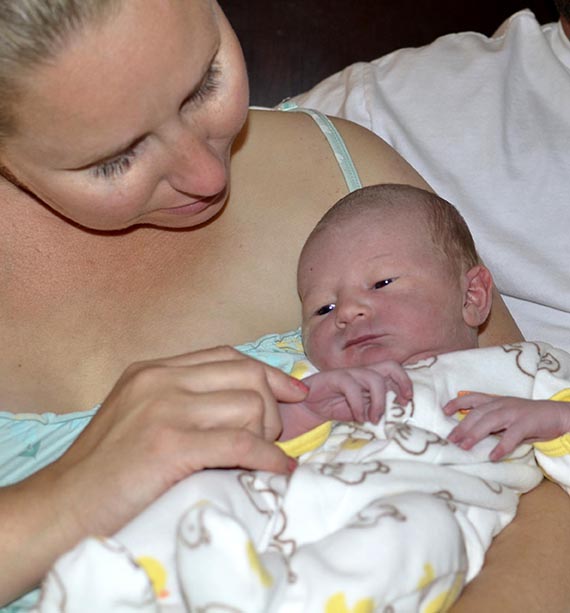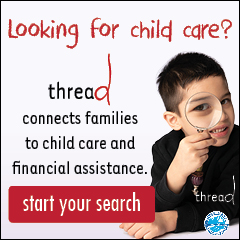LABOR OF love
Where will your baby come into the world?
Find the birth setting that’s right for you
By Amy Newman
Having a baby means making a lot of decisions – choosing a name, buying a car seat, and finding the right pediatrician, to name a few. Fortunately in Alaska, expectant parents have options when it comes to perhaps the most important decision of all – how to welcome your baby into the world. Whether it’s at home, a birthing center or hospital, we explored each birthing option to help you understand what to expect.
Birth in the comfort of home
Home birth often conjures up images of “Birkenstock hippie midwives who are not trained,” says Chinmayo Forro, a certified direct-entry midwife (CDM) and owner of Childbirth with Love in Anchorage. And while it’s true that these expectant mothers avoid all but the most necessary medical interventions, using birthing pools to relieve labor pains – sometimes even birthing the baby in the pool – and laboring with minimal lighting and talking, the stereotype of the untrained midwife is untrue, she says.
CDMs must meet certain study and clinical training requirements imposed by the state in order to be licensed, and must receive continuing education. They are also authorized to administer certain IV drugs for post-partum hemorrhage and group B strep (a bacterial infection that sometimes develops in a pregnant woman’s vagina), which is a change from the early days of licensure, when CDMs could only administer medication via intramuscular injection, Chinmayo says.
Midwives are prohibited from working with high-risk pregnancies, such as mothers who have a history of heart disease or diabetes, who are pregnant with multiples or whose babies present breech or have a medical condition like Downs syndrome. If complications arise during pregnancy, care is transferred to a physician.
Midwives, however, provide an array of services throughout pregnancy that focus on preventing potential complications, Chinmayo says. For example, they counsel new moms on how to eat right to lower the chance of developing gestational diabetes and ways to manage stress to keep blood pressure down.
“Out-of-hospital clients take a lot more responsibility for their care,” she says. “Midwives are very insistent on that. You (the expectant mother) have to ask a lot of questions. You have to do your homework. You have to make informed decisions.”
This is advice local mom Tapia Stover took to heart. Stover, who delivered her first child with Chinmayo recently, reviewed numerous studies regarding the safety of home births for low-risk pregnancies. She also drew on her background as a NICU nurse, certified nurse midwife and doula, before choosing a home birth.
“To me it was important to read the studies to see that home birth is perfectly safe,” she says. “All the studies show that it’s as safe as other birth options.”
In addition to the woman-centered care philosophy, the ability to deliver in the comfort of home is another big draw. That’s why local mom Tiffany Trice chose a home birth for her second child, a son whom Chinmayo recently delivered.
Tiffany’s first child was a hospital birth, and while the experience wasn’t “horrible,” it wasn’t what she had envisioned. “It just wasn’t as intimate as I would have liked,” she says. “I didn’t want to have a lot of hustling and bustling. I wanted a more easy-going and relaxed environment, in my own home, where I was more comfortable.”
And that is the ultimate goal of a home birth, Chinmayo says. “The key to a successful labor is creating the perfect environment for the woman,” she says.
Home away from home
For parents who want an intimate setting for their child’s birth, but don’t want a home birth, birth centers – freestanding clinics not affiliated in any way with a hospital – provide a middle ground, offering a homelike atmosphere to welcome their child into the world.
“They are a place where women are in charge of their birth,” says Barbara Norton, CNM, ANP, and clinical director of the Geneva Woods Birth Center in Anchorage. “(A mother) can expect to have the birth she wants, unless something deviates from normal.”
Like home births, midwives attend to expectant mothers at birth centers, and women who initially present with high-risk pregnancies are referred to obstetricians. If complications develop during pregnancy, birth centers share care with a physician, and midwives can be present if a hospital birth is necessary.
Nurse midwives can legally provide pain medication, although Geneva Woods does not, Barbara says. Instead, pain relief comes from massage, bathtubs and showers, and freedom of movement.
The ability to labor in the birth center’s tub was one of the reasons local mom Ninja Alger chose Geneva Woods for the birth of her daughter in April 2013. The lack of pain medication was another – Ninja wanted a natural delivery, and was afraid she’d cave if an epidural was offered at the hospital.
But it was the homelike atmosphere that convinced her and her husband that the birth center was right for them. “It was really low-key, really personal,” Ninja says. “It felt like you were at home. The lights were low and it was comfortable and pleasant.”
Barbara says there are fewer negative stereotypes associated with birth centers than there were when she started 17 years ago. “People had the misconception that there were no rules, and that we wouldn’t use gloves, and people could do anything they want,” she says. “I think people are more educated about birth options now than they were 10 years ago.”
Ninja, who grew up in the Netherlands where midwifery is the norm, suggests that parents on the fence should visit a birth center to help them decide.
“Just go and compare the two and then see what you feel best with,” she says, which is how she got her husband on board. “I think that is the best way to make a decision, because every birth is unique.”
Today’s hospital birth
Hospitals have come a long way since the days when deliveries took place in cold, uncomfortable and impersonal delivery rooms.
“Things have changed dramatically over the past 20 years,” says Karen Davis, a registered nurse at Alaska Regional Hospital’s Family Birth Center. “Our goal is to give women the birthing experience they desire in a setting that can do emergency cesareans in case of fetal distress.”
The hospital has recently renovated its birthing rooms to make them feel more like home, she says, adding memory foam labor mattresses and pull-out couches for partners to spend the night. Women are encouraged to utilize the sit-down Jacuzzi tub with chromotherapy (colored lights) to ease labor pains and reduce the need for epidurals. A natural delivery is always an option, she says, although there is generally a standing order for IV pain medication or an epidural if the woman changes her mind during labor.
For a hospital birth, women can choose an OB-GYN, a family physician or a certified nurse-midwife (CNM) as their primary caregiver. CNMs routinely deliver at Alaska Regional Hospital, Karen says. And if a woman’s care needs to be transferred due to complications that arise prenatally or during labor, CNMs can remain with the mother to provide support.
“We honor the fact that different women want different birthing experiences,” she says. “We want to be welcoming and provide a great experience for any patient who has a hospital birth.”
For local mom Josie Roberts, who delivered her first two children at hospitals out of state, and her third and fourth at Alaska Regional, being in a hospital, fully equipped with the latest obstetrical technology, gave her peace of mind, she says.
“I want the best available care right then and there,” she says. “If there’s a (complication), I want the doctor right there.”
As it turns out, Josie needed an emergency C-section after her son got stuck in the birth canal.
“I was grateful I was there,” she says. “They handled it very well.”
Finding the right fit
When it comes to pregnancy and delivery, there is no one-method-fits-all approach. Every parent-to-be has a different idea regarding what constitutes the ideal birthing experience. So whether this is your first, second or even fourth pregnancy, make sure to do your research, meet with providers and ask plenty of questions to find the birthing option, and provider, that’s right for you.
Because ultimately, the best birthing experiences are those where both parents feel safe, supported and trust their provider – and their decision on where to deliver – completely.

.jpg)











